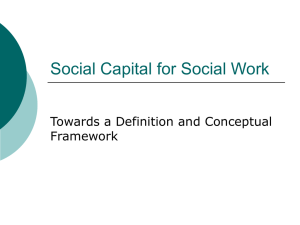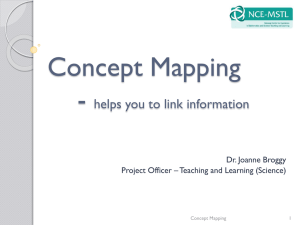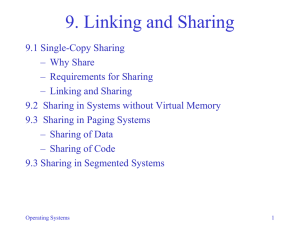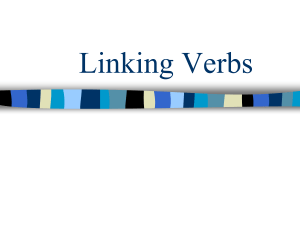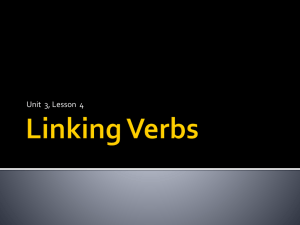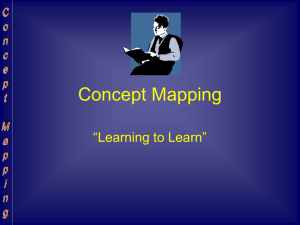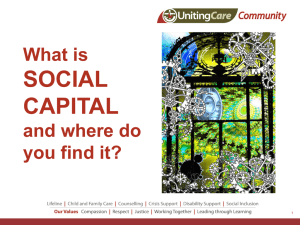Mick Healey - Northumbria University
advertisement
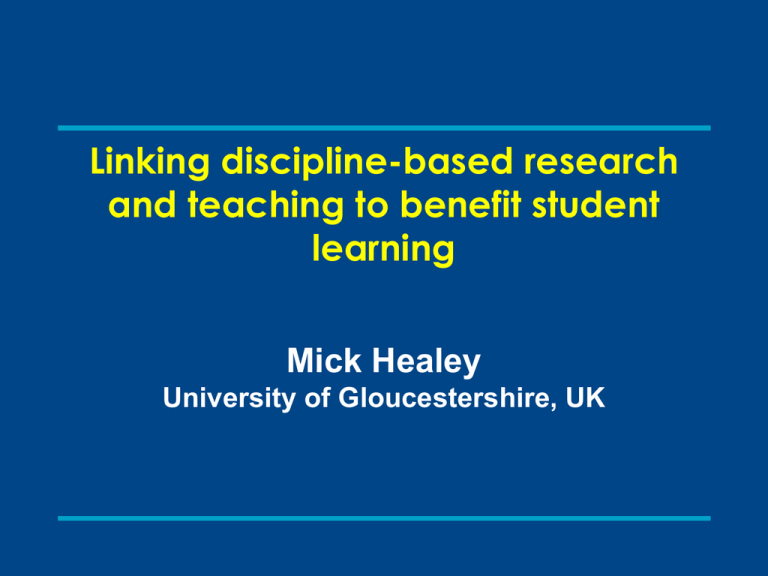
Linking discipline-based research and teaching to benefit student learning Mick Healey University of Gloucestershire, UK Linking research and teaching at Northumbria During the academic years 2006/7 to 2008/9, the University is supporting initiatives designed to meet HEFCE's strategic aim of 'ensuring that teaching is informed and enriched by research'. These are supported with funding gained from HEFCE's Teaching Quality Enhancement Fund and overseen by the Research and Teaching Steering Group – Two rounds of projects, each up to £20K – Annotated bibliography – Research and Teaching module on Academic Practice CPD programme – Red Guide on 'Linking Teaching and Research' Brief Biography • • • • • • • • Economic geographer Director Centre for Active Learning in Geography, Environment and Related Disciplines Director HEAcademy project on Undergraduate research in new universities Co-Director ESRC TLRP Project on Disabled Students’ Learning Geography Advisor to Academy Subject Centre for Geography, Earth and Environmental Sciences VP for Europe International Society for Scholarship of Teaching and Learning National Teaching Fellow Research interests: scholarship of teaching; linking research and teaching; active learning; developing an inclusive curriculum for disabled students Linking research and teaching “We are all researchers now … Teaching and research are becoming ever more intimately related … In a ‘knowledge society’ all students – certainly all graduates – have to be researchers. Not only are they engaged in the production of knowledge; they must also be educated to cope with the risks and uncertainties generated by the advance of science” (Scott 2002, 13) “… universities should treat learning as not yet wholly solved problems and hence always in research mode” (Humboldt 1810, translated 1970, quoted by Elton 2005, 110) Linking research and teaching “It is not teaching but the student experience that should be the focus of the teaching research nexus” (Prosser, 2006) "Involving students in inquiry - in research - is a way of improving their learning, motivating them more. After all, what motivates large numbers of academics is engaging in the excitement of research. Bringing research and teaching together is a way of enhancing the motivation of both academics and students" (Brew, in Jenkins et al, 2003) Linking research and teaching 1. 2. 3. 4. 5. Different ways of linking research and teaching Different views on linking research and teaching Disciplinary perspectives Institutional perspectives Conclusion Linking research and teaching: Line-up I want you to position yourself on a line according to the extent to which you agree or disagree with the following statements Talk to the person next to you about why you have positioned yourself where you have and as a consequence you may need to ‘move’ Linking research and teaching: Line-up It is essential that undergraduate students are aware of the research which goes on in their departments Strongly ------------------------------ Strongly agree disagree Linking research and teaching: Line-up I believe that my teaching and my research are / will be strongly linked Strongly ------------------------------ Strongly agree disagree Different ways of linking R&T • Learning about others’ research • Learning to do research – research methods • Learning in research mode – enquiry based • Pedagogic research – enquiring and reflecting on learning Linking research and teaching: different views • Topic on linking research and teaching has generated much debate, some of it fairly emotive and polarised (Table 2) • Many people hold the view that a key characteristic of universities is where research and teaching are brought together • Some claim that the best researchers are usually the best teachers (e.g. Cooke, 1998) • Others dispute this claim (e.g. Jenkins, 2000); many refer to examples of excellent researchers who are poor teachers and vice versa Linking discipline-based research and teaching to benefit student learning Mick Healey University of Gloucestershire, UK Linking research and teaching: different conceptions of research Source: Brew (2003, 6) Linking research and teaching: different conceptions of teaching Information transfer / teacher focused approach Conceptual change / student focused approach Prosser and Trigwell (1999) Linking research and teaching: Conceptual compatibilities Trading view of research and information transmission approach to teaching Journey view of research and conceptual change approach to teaching Trowler and Wareham (2007) Linking research and teaching: Knowledge transfer and public scholarship Knowledge transfer, knowledge exchange, ‘third stream’ activities – association with enterprise, knowledge economy, vocationalism, professional education and ‘performativity’ Public scholarship – ‘engaging in reciprocally beneficial ways with communities at local, national and international level’ (Krause, 2007, 5); develops from Boyer’s ‘scholarship of engagement’ Linking research and teaching: conception of undergraduate research “Undergraduate research describes student engagement from induction to graduation, individually and in groups, in research / inquiry into disciplinary, professional and communitybased problems and issues, including involvement in knowledge exchange activities” Childs et al., 2007 Linking research and teaching: the nature of research-teaching nexus Griffiths (2004) makes a distinction between teaching which is: • research-led – subject content • research-oriented – inquiry skills • research-based – inquiry-based activities However, terms are used loosely and most academics use a mixture of these approaches STUDENTS AS PARTICIPANTS Research-tutored Research-based EMPHASIS ON RESEARCH CONTENT Research-led Research-oriented EMPHASIS ON RESEARCH PROCESSES AND PROBLEMS STUDENTS AS AUDIENCE Curriculum design and the research-teaching nexus Linking research and teaching: disciplinary perspectives • A discipline-based approach is important in studying the research-teaching nexus because the nature of knowledge construction and research methods differ between disciplines Linking research and teaching: disciplinary perspectives Pure Physics Hard History Soft Geography Engineering Law Applied Different ways of linking R&T: disciplinary perspectives A key issue: How may the linkages between research and teaching be developed to enhance the benefit for student learning? In pairs each skim read the abstracts for ONE different group of DISCIPLINES pp.8-21 OR some of the DEPARTMENT case studies pp2126. Discuss whether any of the ideas may be amended for application in your context 5 minutes Linking research and teaching: disciplinary perspectives Variation by discipline group Subject content – more difficult in hard disciplines than soft Social processes – working with staff as part of a research team more common in hard disciplines than soft Role of professional bodies – danger of ‘curriculum creep’ where accredit entry into profession Students experience of learning in a research environment: Physics What is research? How visible is it? Where is it located? Who does it? Breaking new ground; moving forward; exploration and discovery Laboratories and machinery (ie tools) but often behind closed doors Out there; at a higher level Lecturers Source: Robertson and Blackler (2006) Students experience of learning in a research environment: Geography What is research? Gathering information in the world; answering a question How visible is it? Most visible in the field Where is it located? Who does it? Out there in the field Lecturers and (increasingly over time) students Source: Robertson and Blackler (2006) Students experience of learning in a research environment: English What is research? Looking into; gathering; putting it together; a focus of interest How visible is it? Not tangibly visible but apparent in the dialogue Where is it located? Who does it? In the library; in the head Lecturers and students Source: Robertson and Blackler (2006) Linking research and teaching: institutional perspectives Skim read the abstracts for ONE group of INSTITUTIONS pp26-33 In pairs, discuss whether any of the ideas may be amended for application here 5 minutes For a framework for analysing institutional strategies see end of handout p47 Linking research and teaching: issues in developing R&T nexus • How much do your u/g students know about the research which goes on in your department? • What opportunities are there for students to present / publish / celebrate their research? • Is research-based learning primarily for honours and graduate students? • Is research-based learning for all students or a highly selected group? Students’ perceptions of research A comparison of over 500 final year students’ perceptions of research in Alberta, Royal Holloway and Gloucestershire found (Table 5): • Students agreed that being involved in research activities is beneficial • Students do not perceive the development of their research skills • Communication is one of the issues that we need to address – language used can exclude Students’ perceptions of research: • About three-quarters of the items followed our hypothesis (particularly about the awareness of research) • Those where the hypothesis did not hold up were mainly in the experiences with doing research, where there were no significant differences • Regardless of institution, there is the perception amongst students that learning in an inquiry or research-based mode is beneficial Students’ perceptions of research: • Trigwell (2006) examined 306 students’ perceptions of their learning benefits from a research-stimulated environment in physics and English in 8 low and high RAE-rated departments • He found a strong positive relationship with adopting a deep approach to learning which was independent of discipline and RAE rating Linking research and teaching: issues in developing R&T nexus • How much do your u/g students know about the research which goes on in your department? • What opportunities are there for students to present / publish / celebrate their research? • Is research-based learning primarily for honours and graduate students? • Is research-based learning for all students or a highly selected group? Strategies for linking R&T In groups of twos and threes identify ONE possible strategy or practice that you would like: EITHER to introduce in the department OR for the University to implement Linking research and teaching: Conclusions • Nature of the linkage between teaching and research is complex and contested • Barnett (2003: 157) suggests that there are many pressures that are pulling research and teaching apart: “The twentieth century saw the university change from a site in which teaching and research stood in a reasonably comfortable relationship with each other to one in which they became mutually antagonistic” Linking research and teaching: Conclusions • Adopting a broader definition of research than is currently common is a way forward (Boyer et al.), which should benefit the learning of students in institutions with a range of different missions • Putting greater emphasis on actively engaging students with research, suitably adapted to recognise the variation and complexity of constructing knowledge in different disciplines, is one way of re-linking them in the twenty-first century. Linking research and teaching: Conclusions If an active learning strategy is to become common place in higher education generally then the nature of higher education itself will need to be reconceptualised so that staff and students work together in what Brew (2003, 12) calls “academic communities of practice”. This she argues: “means sharing power and it means being open to challenge” (p.16) There is a need to do more thinking ‘outside the box’. Linking research and teaching to benefit student learning THE END Thank You
